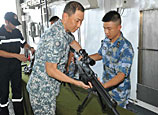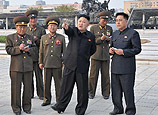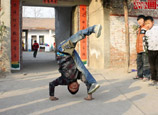
Shanghai is attempting to introduce the 20-meter shuttle run in middle schools to replace the long-distance run, a move that has sparked controversy as many doubt the new test is a solution to teenagers' poor physical condition.
Experts are revising the current system on teenagers' physical fitness and mapping out an exercise intervention plan, according to the Teenagers' Health Evaluation and Exercise Intervention National Key Laboratory under the Ministry of Education.
The 20-meter shuttle run pilot project is under way in the city's 18 schools, with about 5,000 students participating. It is expected to replace the current 800-meter runs for girls and 1,000-meter runs for boys.
The shuttle run involves running back and forth between two points 20 meters apart at increasing speeds.
"The long run failed to scientifically and objectively reflect a student's cardiopulmonary function and aerobic endurance," said Ji Liu, a professor from the school of sports and health at East China Normal University, who is also the leader of the pilot project. "The speed has less connection to their physical status," while cardiopulmonary function and aerobic endurance is an important indicator of a person's fitness, he said.
"The long-distance run is a combination of aerobic and anaerobic exercise, which cannot reflect students' aerobic endurance," Ji said.
The move in Shanghai follows the deaths of two college students in Guangdong province and one in Shanghai after long-distance runs in November. Several colleges and middle schools canceled long-run projects in their sports contests after the deaths.
Ji argued the replacement is not a "compromise", and that the energy consumed in the 20-meter shuttle run is exactly the same amount as that of the long-distance run. "It doesn't mean the long run will be left out. On the contrary, it will still work as an important exercise item for students. Students are extremely encouraged to participate in various exercises," Ji said.
The long distance runs have proves a nightmare for many students. Physical education scores in junior high school are counted into students' total scores for graduation, which means the long-run scores will affect the level of the high school students will get to attend.
"The long-distance run was pure hell. I would have some chocolates before the run. Especially when my grades were related to the entrance examination, I would become cautious," said Cao Yue, a female student.
Meanwhile, some experts doubt that the shuttle run can guarantee students' safety and health. Lu Yuanzhen, professor of the school of physical education and sports science at South China Normal University, called for more prudent consideration before implementing the 20-meter shuttle run.
Questioning whether cardiopulmonary function can be measured through the shuttle run, Lu said the shuttle run cannot reduce the potential harm to students such as passing out and sudden death. Besides, the sudden stops and turning around during the shuttle run will hurt students' knees.
But Ji defended the move. "Compared with years ago, Chinese students are becoming weaker in fitness, such as strength and physical endurance. The reason is from their heavy academic burden. They are forced to pay more attention to academic scores. They have little time to sleep, let alone exercise," Ji said.


















![]()
